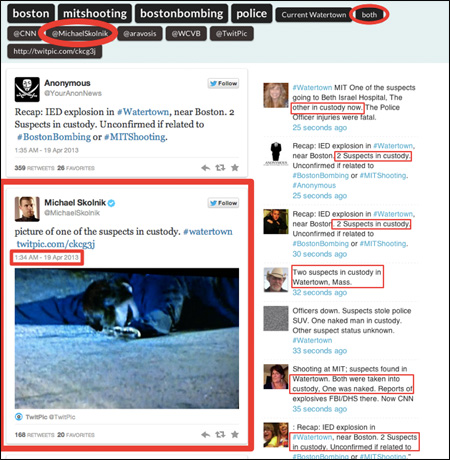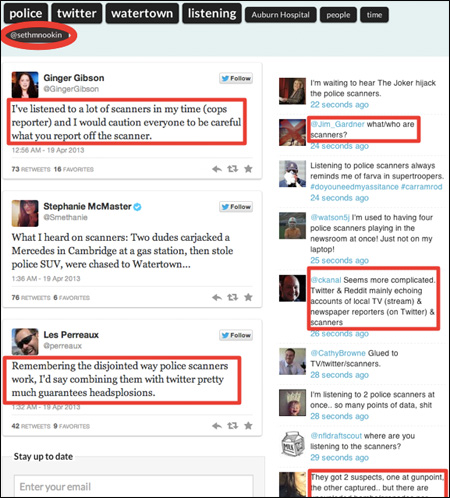Twitter coverage of the manhunt in Watertown marks a wake-up call to journalists everywhere. Even more remarkable are the implications for ordinary citizens who, without a press pass, intentionally plant themselves on the scene to witness and tweet what they see in real time. For the latter group of news gatherers, this event instills a newfound sense of power and responsibility in how they verify and disseminate news; i.e., gain credibility and authority as a news source.
Finding and vetting reliable sources is the ghost that haunts investigative journalism past, present and future. Tools and processes for assessing source credibility need to catch up with ever evolving social media technology and culture, especially in dangerous environments in which the public relies on reporters to provide actionable news updates with minimal misinformation and fallout.
I was sitting in my first-floor apartment in Harvard Square on Thursday night. Suddenly, five police cars zoomed past my window. The first thought that popped into my mind was: They must be rushing to investigate a tip on the Boston marathon bombing suspects. I went to my computer to look at photos of the suspects. Then the drama on Twitter enthralled me for the next ten hours. I opened Tweetdeck, creating a column for "suspects". The feed was updating so fast that my eyes couldn't even scan it.
The Nieman Foundation invited me as a visiting fellow to look into how journalists can use Twitter to stay up to date with breaking news. One of my projects is to build a social media monitoring software tool that I call Keepr. I started by searching for "suspects" in Keepr and found some interesting keywords: "MITShooting", "Police Radio", "Watertown". My algorithm pulls the 100 most recent tweets from Twitter's API and counts the words and phrases that occur most frequently. However, there was still plenty of noisy misinformation. At one point, everyone was tweeting that both suspects had been taken into custody.

Screenshot of Keepr search for "Watertown" shows examples of misinformation stating that both suspects are in custody. View larger image »

Screenshot of Keepr discovering Seth Mnookin as a source and conversations about the efficacy of tweeting police scanners. View larger image »
Even more interesting, Keepr discovers Twitter users who are most frequently mentioned. For instance, I found Michael Skolnik. Then I manually scanned his tweets to find who he was retweeting and mentioning. By repeating this process, I compiled a Twitter List of about 15 users who were on the scene and live-tweeting what they saw with their own eyes. Even more difficult was the judgment call to verify what they heard from other sources and make a split-second decision to retweet that information. Of course, I wasn't the only person to come up with the idea of creating a Twitter List to follow the up-to-the-second updates. A more comprehensive list of journalists by Danny Sullivan was used by tens of thousands of people to "tune in" to the breaking story.
I could not sleep, not just because of the excitement, but I didn't know who and what to believe. Was the second suspect still on the loose? Did he have accomplices? What if they headed toward Harvard Square? Out of fear, I closed all my window shades, turned off all lights. It was pitch dark, and I kept staring at Twitter on my iPhone for updates.
Thoughts race through my mind as I examine my own criteria for building up trust in sources. Four factors stood out in my mind as indicators of credibility: disclosure of location; multiple source verification; original raw footage; accuracy over time.
First, the source willingly discloses her location in her tweets (perhaps even geocodes them). Related to that, she has to be seen, mentioned or retweeted by other eyewitnesses at the scene. Furthermore, she uploads original photos or video footage or quotes from official authorities, such as a press conference. Lastly, her Twitter profile (and other social media presence), archive of tweets before the event, and tweeting accuracy during the course of the event all contribute signals of trustworthiness.
Jeremy Stahl insightfully extends Philip Graham's adage: "If journalism is the first rough draft of history, then Twitter is the first rough draft of journalism." This preliminary analysis scratches the surface of lessons learned from coverage of the Watertown news story. Source credibility has always been a conundrum for investigative journalists and will become even more so as mobile devices and social media empower citizen "experts/sources" to emerge and become the "go to" sources for mainstream media. I will continue to research and develop tools that semi-automate this process.
Finding and vetting reliable sources is the ghost that haunts investigative journalism past, present and future. Tools and processes for assessing source credibility need to catch up with ever evolving social media technology and culture, especially in dangerous environments in which the public relies on reporters to provide actionable news updates with minimal misinformation and fallout.
I was sitting in my first-floor apartment in Harvard Square on Thursday night. Suddenly, five police cars zoomed past my window. The first thought that popped into my mind was: They must be rushing to investigate a tip on the Boston marathon bombing suspects. I went to my computer to look at photos of the suspects. Then the drama on Twitter enthralled me for the next ten hours. I opened Tweetdeck, creating a column for "suspects". The feed was updating so fast that my eyes couldn't even scan it.
The Nieman Foundation invited me as a visiting fellow to look into how journalists can use Twitter to stay up to date with breaking news. One of my projects is to build a social media monitoring software tool that I call Keepr. I started by searching for "suspects" in Keepr and found some interesting keywords: "MITShooting", "Police Radio", "Watertown". My algorithm pulls the 100 most recent tweets from Twitter's API and counts the words and phrases that occur most frequently. However, there was still plenty of noisy misinformation. At one point, everyone was tweeting that both suspects had been taken into custody.

Screenshot of Keepr search for "Watertown" shows examples of misinformation stating that both suspects are in custody. View larger image »

Screenshot of Keepr discovering Seth Mnookin as a source and conversations about the efficacy of tweeting police scanners. View larger image »
Even more interesting, Keepr discovers Twitter users who are most frequently mentioned. For instance, I found Michael Skolnik. Then I manually scanned his tweets to find who he was retweeting and mentioning. By repeating this process, I compiled a Twitter List of about 15 users who were on the scene and live-tweeting what they saw with their own eyes. Even more difficult was the judgment call to verify what they heard from other sources and make a split-second decision to retweet that information. Of course, I wasn't the only person to come up with the idea of creating a Twitter List to follow the up-to-the-second updates. A more comprehensive list of journalists by Danny Sullivan was used by tens of thousands of people to "tune in" to the breaking story.
Livetweets from reporters on the ground at Watertown - follow this Twitter List https://t.co/bdtIrKhCh9 #MITShooting
— Hong (@hqu) April 19, 2013this lets you see tweets from various people on-scene or near watertown as single stream twitter.com/dannysullivan/…
— Danny Sullivan (@dannysullivan) April 19, 2013
I could not sleep, not just because of the excitement, but I didn't know who and what to believe. Was the second suspect still on the loose? Did he have accomplices? What if they headed toward Harvard Square? Out of fear, I closed all my window shades, turned off all lights. It was pitch dark, and I kept staring at Twitter on my iPhone for updates.
Thoughts race through my mind as I examine my own criteria for building up trust in sources. Four factors stood out in my mind as indicators of credibility: disclosure of location; multiple source verification; original raw footage; accuracy over time.
First, the source willingly discloses her location in her tweets (perhaps even geocodes them). Related to that, she has to be seen, mentioned or retweeted by other eyewitnesses at the scene. Furthermore, she uploads original photos or video footage or quotes from official authorities, such as a press conference. Lastly, her Twitter profile (and other social media presence), archive of tweets before the event, and tweeting accuracy during the course of the event all contribute signals of trustworthiness.
Jeremy Stahl insightfully extends Philip Graham's adage: "If journalism is the first rough draft of history, then Twitter is the first rough draft of journalism." This preliminary analysis scratches the surface of lessons learned from coverage of the Watertown news story. Source credibility has always been a conundrum for investigative journalists and will become even more so as mobile devices and social media empower citizen "experts/sources" to emerge and become the "go to" sources for mainstream media. I will continue to research and develop tools that semi-automate this process.


